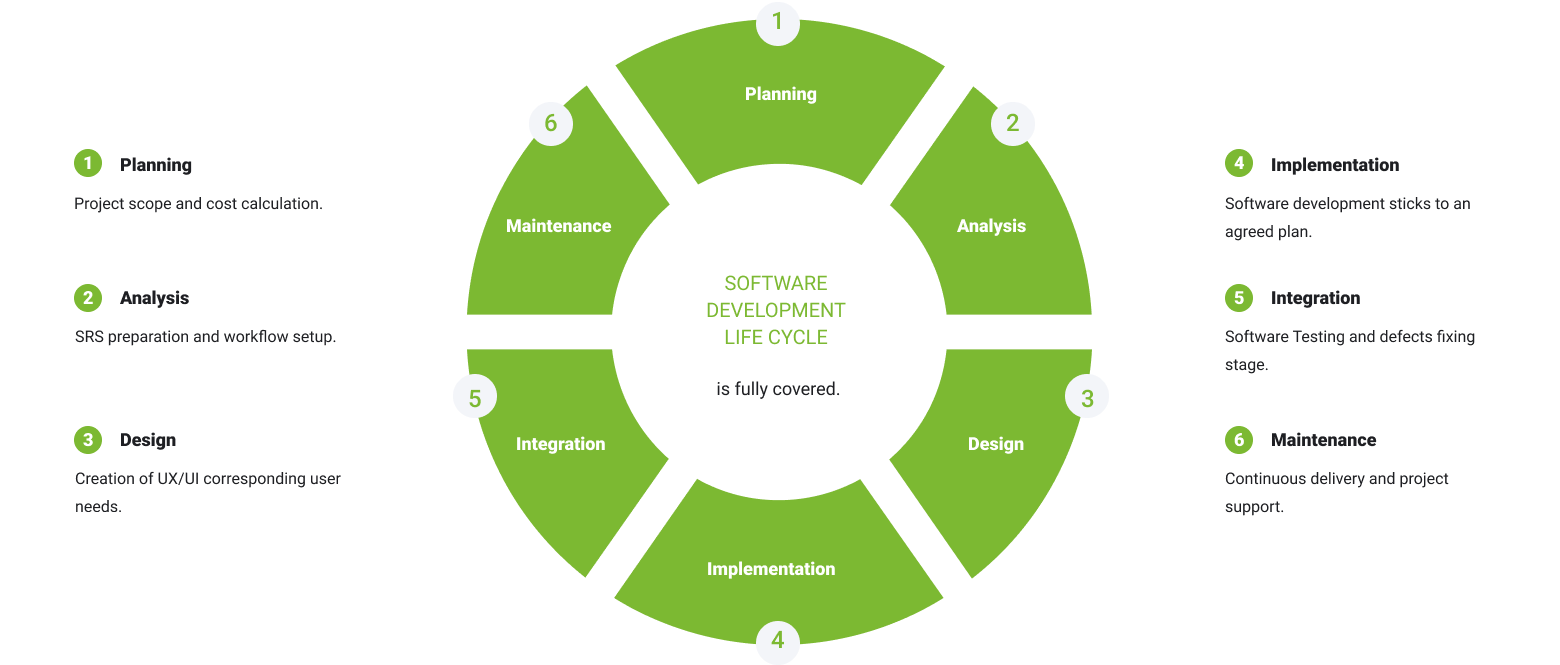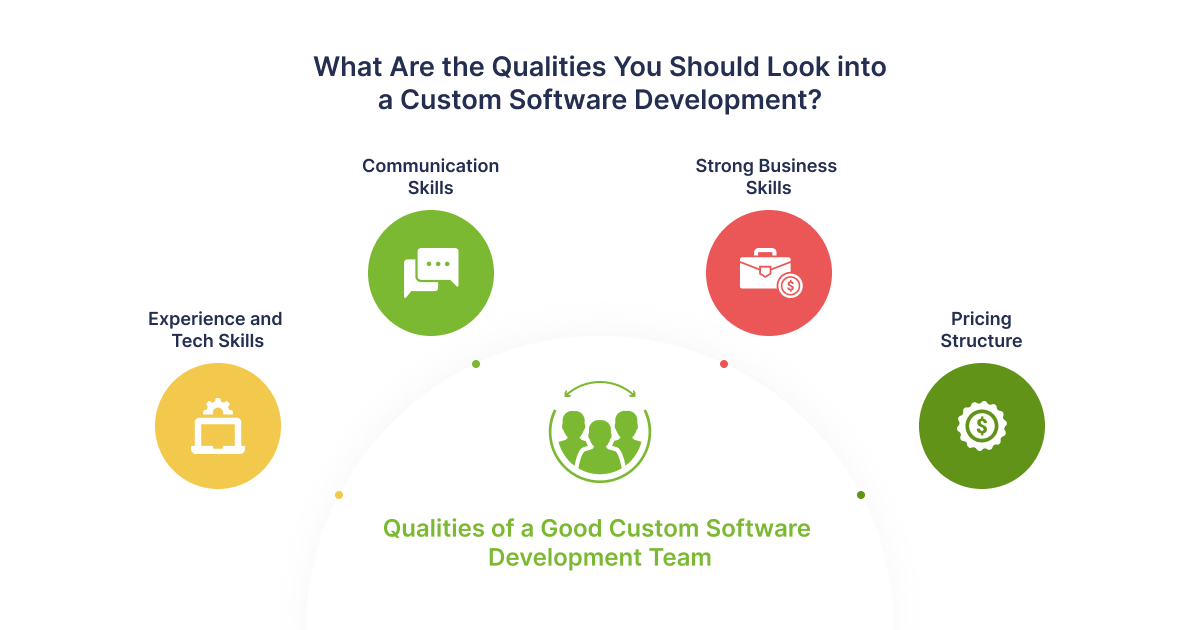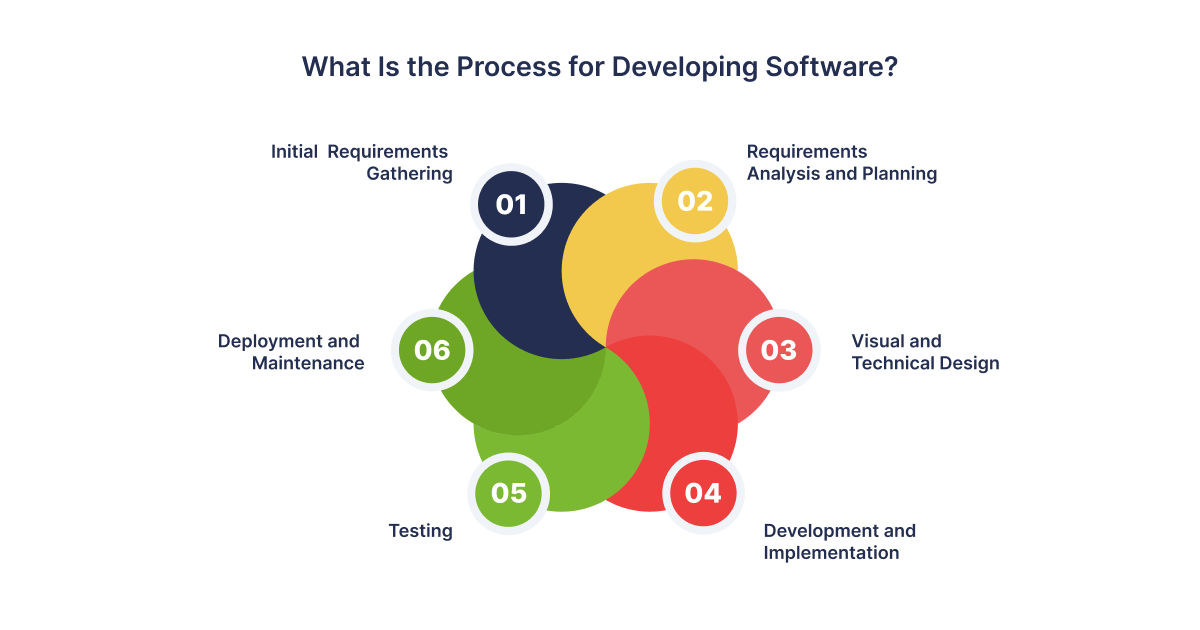Stages of Custom Software Development
Useful, successfully implemented software makes a story of a product that meets business needs. It is better to entrust its creation to a reputable, experienced contractor who will not only complete the tasks, but also discuss with you the details of the concept implementation, and also keep informing you about all the stages of software development. As a rule, customers who have not previously encountered the process of writing a program can be frightened by the volume and multi-stage work. Therefore, it is better to have a quick look at the steps in the development of custom software you have to go through.
Brainstorming and conceptualizing an idea
Any project starts with a discussion of an idea. By voicing theses and working moments, you are gradually narrowing down the range of problems that the product should solve. The joint work of a customer and a contractor with the voicing of all possible ideas becomes the first step towards creating software with the required characteristics.

Planning
Have you already outlined the idea? Next, the developers move on to its conceptualization and planning actions for its implementation. As a matter of fact, the project as an idea is the potential of the customer to solve a specific business problem. And the contractor must offer a solution that would not repeat the existing ones on the market.
While planning, experts evaluate the project for its advantages and disadvantages. To do this, they consider in detail the problem and the data available for the moment. What are the important aspects of planning?
- Transparent communication. The development team and end users must be honest while discussing plans to ensure a seamless software development process;
- It is impossible to do planning without preliminary brainstorming.
To understand how the project should work, it is necessary to operate with evidence of the usefulness of the idea, its profitability and payback. In other words, accurate planning can be done under the condition of careful processing of a large amount of data.

Analysis
Business analysis means examining the idea of developing software that will help avoid inexpedient investments and the collapse of the project. This is nothing but feasibility study that determines the viability and competitiveness of the concept.
System analysis suggests that:
- new details and branched solutions are added to the developments obtained at the earlier stage, described above. The entire software system is registered;
- The entire pool of work is divided into small modules with assigned tasks. It is vital to do everything for effective management so as not to miss anything in the process;
- Splitting a project into smaller parts of work makes it easier for the tasks to be understood and completed by the multiple people engaged in the implementation. It is also convenient to control and correct errors at the final stage.
Prototyping and design
Creating a system design allows you to recreate the interaction within the program, make the interface structured and ordered. In the course of work, a list of templates, colors, styles of text blocks, patterns is outlined. This set lists all the tools needed to create a system design. The plan gives an idea of how the software will look and work.
Development and coding
Coding is one of the most structurally complex stages of custom software development, where you need to complete a number of processes, including setting up the infrastructure. In the course of the work, documents that determine the nature of the operation of the programming system are prepared. What do you need to know?
- The scope of work to be performed during the development process must be specified during planning and design.
- The role of the project manager is very important, which does not only include management of the scope of work and the progress of the project, but also maintains constant communication with the customer, reducing the risks of the project.
Testing
After developing and coding custom software, the contractor proceeds to its testing. At this stage, a thorough check of the product is carried out, after which the results are made public. Demonstration of test results allows you to get constructive feedback.
An important step is the transfer of the product to users. But before that, the program is checked by quality control groups: possible errors are identified here and they are successfully corrected. When testing confirms the absence of errors, the software is transferred to the next stage. Read more about the interaction between BA and QA.
Implementation / launch
If the project does not contain errors, it is launched. Users take advantage of the software and leave feedback about it.
Support
Establishing transparent communication with users, which is especially important at the launch stage, is impossible without a full-fledged support service. Specialists collect information about the difficulties and issues that arise in the process of using the software, analyze ideas and suggestions to improve the functioning of the product. This is the way to solve problems, correct them. What is important to remember?
- Implementation is the final stage of the software life cycle. This step is impossible without real use, which involves identifying possible shortcomings and adapting the program.
- The found errors are analyzed by the quality control group, whose employees interact with programmers and designers. If no errors are discovered during the work, the software is transferred for deployment.
Deployment
Deployment is the last step in the custom software development process. Efforts are aimed at introducing the product into production and showing its viability, effectiveness, and the benefits of using it in real life. After deployment, all users have access to the software. In its turn,
the deployment stage is divided into sub-stages - preparation, deployment procedure, actual deployment, transfer of ownership and closing the deployment. Customers generally have ownership, but contractors are responsible for storing software.
Maintenance
During maintenance, some measures are taken to repair the software, update it and eliminate errors. In addition, specialists deal with the integration of the application with new systems that the client implements. It is reasonable to talk about maintenance only after the full launch and deployment of the program. Actually, the maintenance service monitors efficiency of the software work.
| Stage | Description |
|---|---|
| Planning | Gathering requirements, analyzing business needs, defining project scope, creating a project roadmap, and estimating the budget and timeline. |
| Design | Creating wireframes, mockups, and prototypes of the software, designing the user interface and user experience, and developing a technical architecture. |
| Development | Writing code and programming the software, testing and debugging the code, and integrating different modules and components. |
| Quality Assurance | Conducting manual and automated tests, identifying and fixing defects and issues, and ensuring the software meets quality standards. |
| Deployment | Preparing the software for production, installing and configuring the software on the server and client machines, and providing user training and support. |
| Maintenance | Providing ongoing support, troubleshooting issues and bugs, adding new features and functionality, and updating the software to ensure compatibility with new technologies and platforms. |
Conclusions
Creating custom software is a rather a complex and multi-stage process, which requires resources, planning, and analysis of a large amount of data. After getting acquainted with the stages of software development, customers will be able to immerse themselves in the work process, avoid mistakes, and finally find a reputable developer.
SDH has solid expertise in custom development of software, mobile and web applications. We accompany the client at all stages of cooperation and make every effort to create a profitable, effective software.
Categories
Share
Need a project estimate?
Drop us a line, and we provide you with a qualified consultation.











